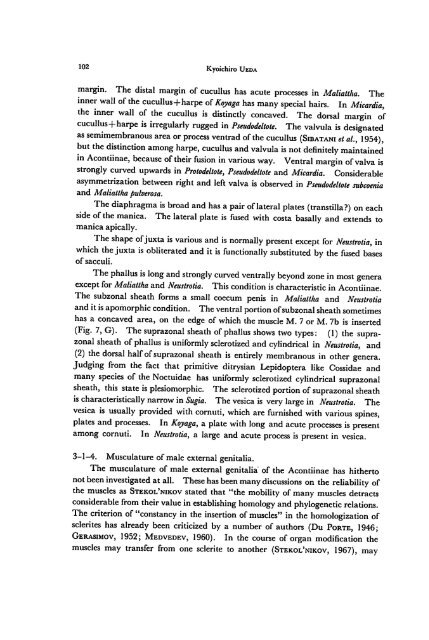A revision of the genus Deltote RL and its allied genera from Japan ...
A revision of the genus Deltote RL and its allied genera from Japan ...
A revision of the genus Deltote RL and its allied genera from Japan ...
Create successful ePaper yourself
Turn your PDF publications into a flip-book with our unique Google optimized e-Paper software.
102 Kyoichiro Ueda<br />
margin. The distal margin <strong>of</strong> cucullus has acute processes in Maliattha. The<br />
inner wall <strong>of</strong> <strong>the</strong> cucullus+harpe <strong>of</strong> Koyaga has many special hairs. In Micardia,<br />
<strong>the</strong> inner wall <strong>of</strong> <strong>the</strong> cucullus is distinctly concaved. The dorsal margin <strong>of</strong><br />
cucullus-f-harpe is irregularly rugged in Pseudodeltote. The valvula is designated<br />
as semimembranous area or process ventrad <strong>of</strong> <strong>the</strong> cucullus (Sibatani et al., 1954),<br />
but <strong>the</strong> distinction among harpe, cucullus <strong>and</strong> valvula is not definitely maintained<br />
in Acontiinae, because <strong>of</strong> <strong>the</strong>ir fusion in various way. Ventral margin <strong>of</strong> valva is<br />
strongly curved upwards in Protodeltote, Pseudodeltote <strong>and</strong> Micardia. Considerable<br />
asymmetrization between right <strong>and</strong> left valva is observed in Pseudodeltote subcoenia<br />
<strong>and</strong> Maliattha pulverosa.<br />
The diaphragma is broad <strong>and</strong> has a pair <strong>of</strong>lateral plates (transtilla?) on each<br />
side <strong>of</strong><strong>the</strong> manica. The lateral plate is fused with costa basally <strong>and</strong> extends to<br />
manica apically.<br />
The shape <strong>of</strong>juxta is various <strong>and</strong> is normally present except for Neustrotia, in<br />
which <strong>the</strong> juxta is obliterated <strong>and</strong> it is functionally substituted by <strong>the</strong> fused bases<br />
<strong>of</strong>sacculi.<br />
The phallus is long <strong>and</strong> strongly curved ventrally beyond zone in most <strong>genera</strong><br />
except for Maliattha <strong>and</strong> Neustrotia. This condition ischaracteristic in Acontiinae.<br />
The subzonal sheath forms a small coecum penis in Maliattha <strong>and</strong> Neustrotia<br />
<strong>and</strong>it isapomorphic condition. Theventral portion <strong>of</strong>subzonal sheath sometimes<br />
has a concaved area, on <strong>the</strong> edge <strong>of</strong> which <strong>the</strong> muscle M. 7or M. 7b is inserted<br />
(Fig. 7, G). The suprazonal sheath <strong>of</strong> phallus shows two types: (1) <strong>the</strong> suprazonal<br />
sheath <strong>of</strong>phallus is uniformly sclerotized <strong>and</strong> cylindrical in Neustrotia, <strong>and</strong><br />
(2) <strong>the</strong> dorsal half <strong>of</strong>suprazonal sheath is entirely membranous in o<strong>the</strong>r <strong>genera</strong>.<br />
Judging <strong>from</strong> <strong>the</strong> fact that primitive ditrysian Lepidoptera like Cossidae <strong>and</strong><br />
many species <strong>of</strong> <strong>the</strong> Noctuidae has uniformly sclerotized cylindrical suprazonal<br />
sheath, this state is plesiomorphic. The sclerotized portion <strong>of</strong>suprazonal sheath<br />
is characteristically narrow inSugia. The vesica is very large in Neustrotia. The<br />
vesica is usually provided with cornuti, which are furnished with various spines,<br />
plates <strong>and</strong> processes. In Koyaga, a plate with long <strong>and</strong> acute processes is present<br />
among cornuti. In Neustrotia, a large <strong>and</strong> acute process is present in vesica.<br />
3-1-4. Musculature <strong>of</strong> male external genitalia.<br />
The musculature <strong>of</strong> male external genitalia <strong>of</strong> <strong>the</strong> Acontiinae has hi<strong>the</strong>rto<br />
not been investigated at all. These has been many discussions on <strong>the</strong> reliability <strong>of</strong><br />
<strong>the</strong> muscles as Stekol'nikov stated that "<strong>the</strong> mobility <strong>of</strong>many muscles detracts<br />
considerable <strong>from</strong> <strong>the</strong>ir value inestablishing homology <strong>and</strong> phylogenetic relations.<br />
The criterion <strong>of</strong>"constancy in <strong>the</strong> insertion <strong>of</strong>muscles" in <strong>the</strong> homologization <strong>of</strong><br />
sclerites has already been criticized by a number <strong>of</strong> authors (Du Porte, 1946;<br />
Gerasimov, 1952; Medvedev, 1960). In <strong>the</strong> course <strong>of</strong> organ modification <strong>the</strong><br />
muscles may transfer <strong>from</strong> one sclerite to ano<strong>the</strong>r (Stekol'nikov, 1967), may
















